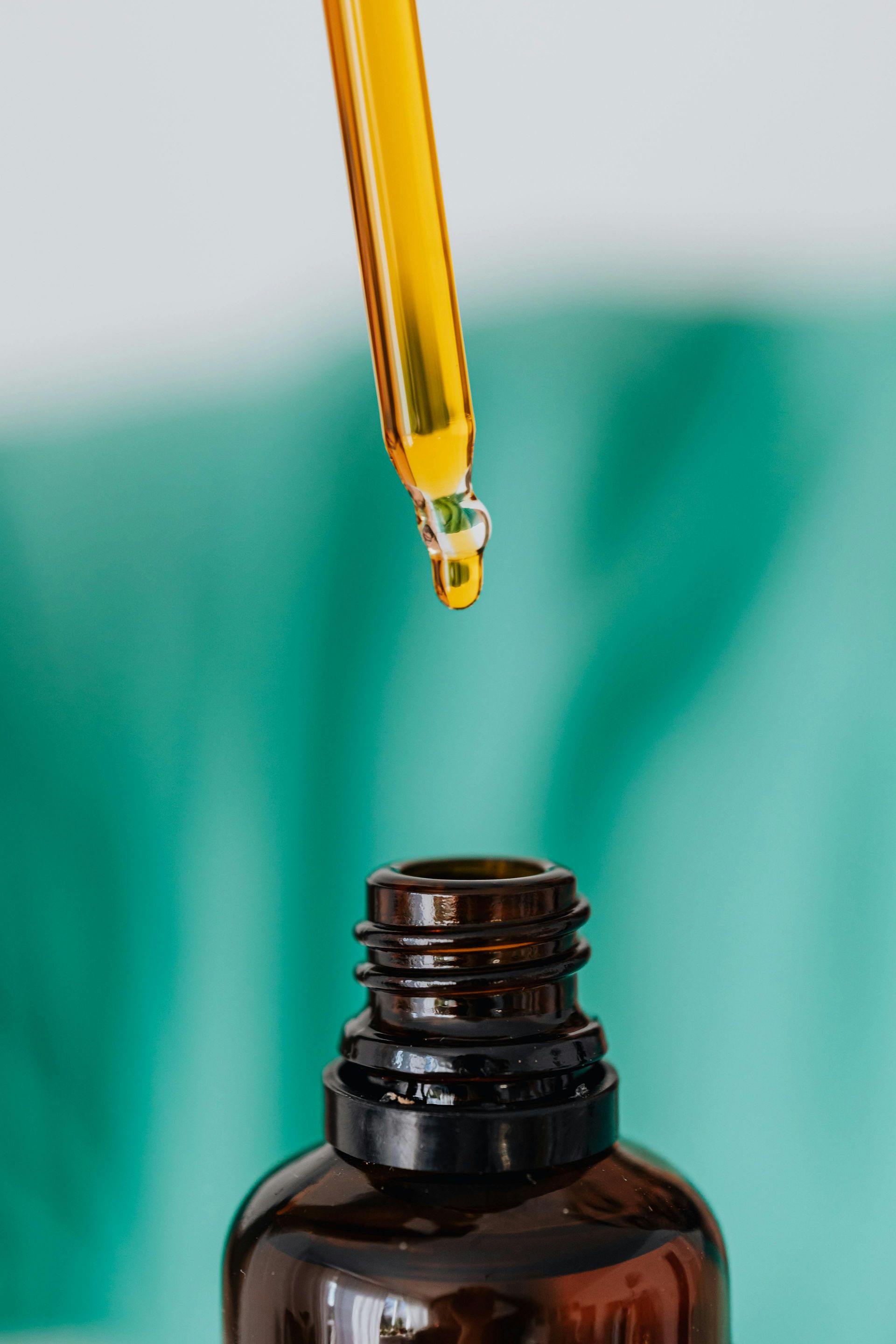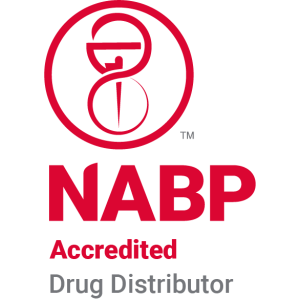The Role of Medical Teams in Managing TPN for Women
A Comprehensive Overview of TPN Management in Women by Healthcare Teams
Total parenteral nutrition (TPN) is a lifesaving form of nutritional support for women with complex gastrointestinal conditions or those unable to meet their nutritional needs orally or enterally. The management of TPN involves a coordinated effort among a multidisciplinary healthcare team, including physicians, pharmacists, dietitians, and nurses, whose combined expertise ensures safe, effective, and individualized patient care. This article explores the critical roles, best practices, clinical considerations, and safety measures that underpin successful TPN management in women, emphasizing the importance of specialized training, evidence-based protocols, and interprofessional collaboration.
Roles and Responsibilities of the Medical Team in TPN Management for Women
What are the roles and responsibilities of a medical team in managing total parenteral nutrition (TPN) for women?
Managing TPN in women requires a coordinated team effort involving healthcare professionals such as physicians, pharmacists, dietitians, and nurses. Each member plays a vital role in ensuring that nutritional therapy is effective, safe, and tailored to each patient's individual needs.
The physician oversees the overall treatment plan, assesses the patient's medical condition, and determines the necessity and duration of TPN. They also set goals for nutritional support based on the patient's diagnosis, prognosis, and comorbidities.
Pharmacists contribute by selecting the appropriate TPN formulations, ensuring compatibility of all components, and adjusting the mixture as per laboratory results and clinical response. Their expertise helps prevent errors related to medication and nutrient interactions.
Dietitians focus on evaluating nutritional status through comprehensive assessments, developing personalized nutrition plans, and monitoring responses to therapy. They also play a role in educating patients and families about TPN, including potential benefits and risks.
Nurses are crucial in the preparation, verification, and administration of TPN solutions. They follow strict aseptic techniques during line care, monitor for signs of complications such as infection, hyperglycemia, or electrolyte imbalances, and maintain meticulous records of intake, output, and clinical findings.
Continuous monitoring is essential to detect and address metabolic, electrolyte, and liver function changes promptly. Laboratory tests such as blood glucose, electrolytes, liver enzymes, and renal function are regularly checked, and therapy is adjusted accordingly.
Effective communication among the team members is key to the success of TPN management. Regular meetings, shared documentation, and interdisciplinary collaboration help coordinate care, respond quickly to changes, and prevent complications.
The ultimate goal of this coordinated effort is to provide adequate nutrition to support healing and recovery, prevent adverse effects, and improve overall patient outcomes. This multidisciplinary approach ensures that TPN therapy is applied safely, responsibly, and efficiently, especially in women with complex medical needs.
How does the collaboration among healthcare professionals optimize TPN safety and efficacy?
By pooling their expertise, the team can tailor nutritional interventions precisely, monitor for and mitigate potential complications, and educate patients effectively. This comprehensive approach enhances the quality of care and supports women through their recovery process, emphasizing safety, personalization, and teamwork.
Key Healthcare Professionals Involved in TPN for Women
Who are the key healthcare professionals involved in TPN management for women?
Managing total parenteral nutrition (TPN) in women requires collaboration among various healthcare professionals, each playing a distinct and vital role. Physicians, including primary care doctors, gastroenterologists, and surgeons, are responsible for assessing the nutritional needs of the patient. They determine the indication for TPN, establish treatment goals, and regularly oversee the overall management to ensure safety and effectiveness.
Pharmacists are essential in preparing TPN solutions. They ensure the formulation's sterility, stability, and compatibility, and advise on appropriate medication administration within the TPN regimen. Their expertise helps prevent complications such as drug-nutrient interactions and ensures that the solutions meet the specific requirements tailored to the patient.
Dietitians evaluate the patient’s nutritional status through comprehensive assessments. They calculate caloric needs, select appropriate nutrients, and design individualized feeding plans that align with the patient’s health condition, medical treatments, and personal preferences. Dietitians also monitor ongoing nutritional adequacy and make adjustments accordingly.
Nurses, particularly those specialized in nutrition or infusion therapy, are responsible for the practical aspects of TPN management. Their duties include inserting and maintaining central venous access devices, preparing or verifying TPN solutions, and administering the nutrition through infusion pumps. They closely monitor the patient for signs of complications such as infection, electrolyte imbalances, and hyperglycemia, and provide patient education regarding line care and potential side effects.
Additional team members enhance the quality of care, including imaging technicians who assist in catheter placement, home infusion nurses who support patients on long-term TPN, and other specialists like infectious disease experts or hepatologists when managing complications.
This multidisciplinary approach promotes a safe, effective, and tailored nutritional therapy that prioritizes patient wellbeing and optimizes outcomes for women requiring TPN.
Guidelines for Administering and Monitoring TPN in Female Patients
What are the best practices and guidelines for administering and monitoring TPN in female patients?
Administering Total Parenteral Nutrition (TPN) to female patients requires meticulous planning and execution to ensure safety and nutritional adequacy. The formulation must be individualized, considering factors such as age, weight, metabolic demands, and underlying health conditions. This tailored approach helps provide the correct balance of macronutrients—carbohydrates, proteins, and fats—as well as essential vitamins, minerals, electrolytes, and trace elements.
Strict aseptic technique is crucial during the insertion, handling, and care of the central venous catheter (CVC) used for TPN delivery. Healthcare professionals, including nurses and clinicians, should adhere to protocols that minimize infection risk, such as hand hygiene, sterile barrier precautions, and regular line dressing changes. All components of the TPN solution should be verified against physician orders before administration to prevent errors and ensure compatibility, especially when medications are added.
Monitoring of the patient is a continuous process that involves multiple parameters to detect and address potential complications early. Regular measurement of blood glucose levels is mandatory, given the risk of hyperglycemia from high dextrose concentrations. Serum electrolytes—sodium, potassium, chloride, magnesium, and phosphate—must be checked frequently to prevent imbalances that could lead to cardiac or neuromuscular issues.
Liver function tests are performed periodically because prolonged TPN use can cause hepatobiliary complications, including cholestasis or steatosis. Triglyceride levels should also be monitored if lipid emulsions are part of the formulation. In patients at risk, vigilance for refeeding syndrome—a potentially fatal shift in electrolytes and fluids—is vital, especially in severely malnourished individuals.
The use of central venous access devices such as PICC lines, tunneled catheters, or implantable ports is standard for hyperosmolar solutions like TPN. Correct placement, maintenance, and careful assessment of the insertion site help prevent infections and thrombosis. It is essential to assess water balance and cardiovascular stability routinely, as TPN provides significant fluid volumes.
Adjustments to the nutritional regimen should be based on ongoing evaluations, laboratory results, and clinical response. Emerging clinical evidence emphasizes the importance of multidisciplinary teamwork—comprising physicians, pharmacists, dietitians, and nurses—in overseeing TPN therapy. This collaboration ensures comprehensive assessment, tailored adjustments, and prompt management of complications.
Educating patients and caregivers about line care, infection prevention, and recognizing adverse signs is an integral part of the therapy. Proper training on sterile techniques for line handling fosters confidence and reduces the likelihood of complications.
In summary, safe TPN administration in female patients hinges on personalized formulation, rigorous infection control, vigilant monitoring, and collaborative care. These practices align with best practice guidelines designed to optimize nutritional support and minimize risks, ultimately improving patient outcomes.
Impact of TPN Management on Women's Health and Nutritional Outcomes
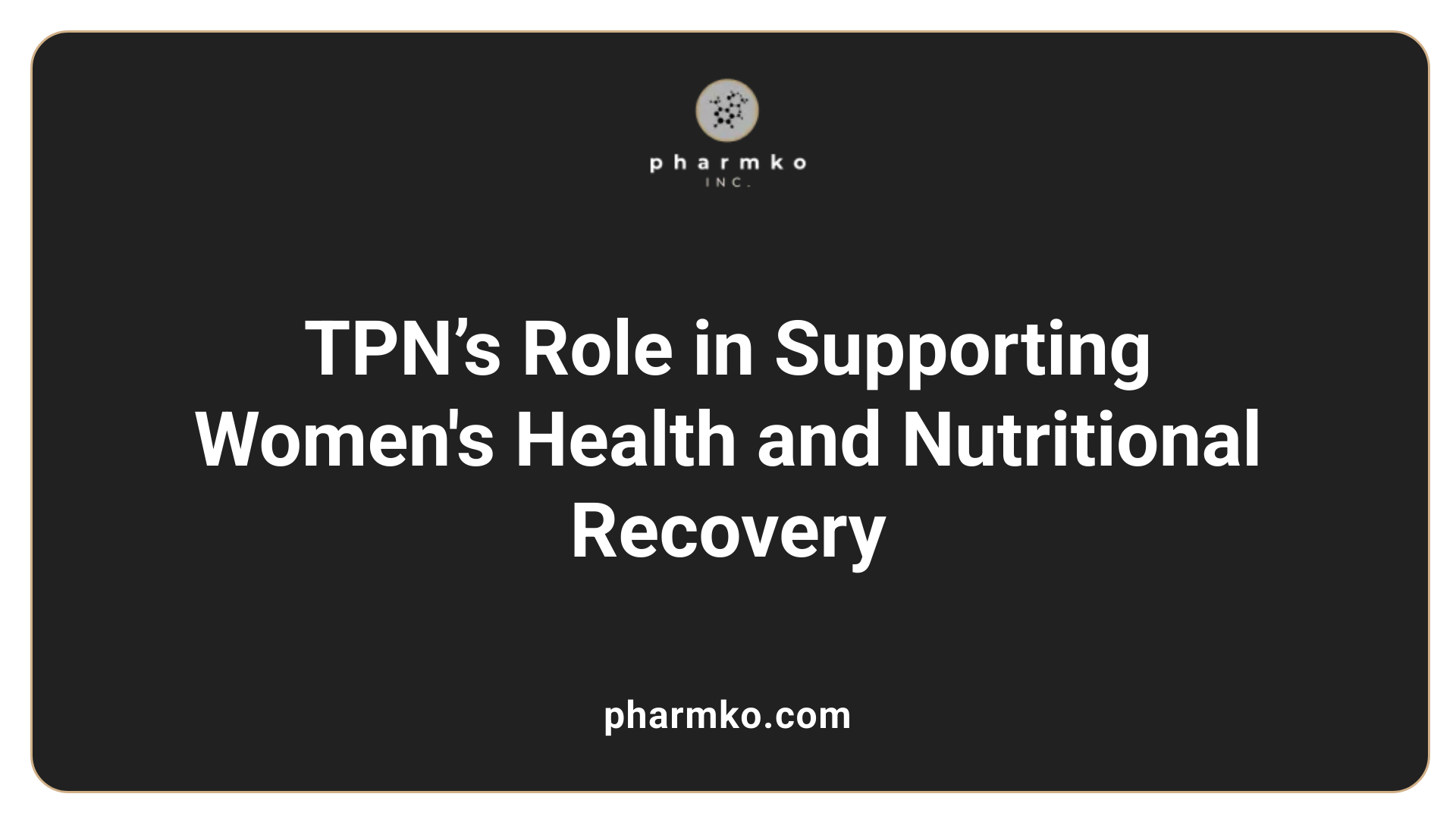
What impact does TPN management have on women's health and nutritional outcomes?
Total parenteral nutrition (TPN) offers a vital solution for women experiencing severe gastrointestinal issues that impair nutrient absorption, such as Crohn’s disease, short bowel syndrome, or during high-risk pregnancies complicated by hyperemesis gravidarum. When managed properly, TPN ensures that women maintain adequate nutritional intake, which is instrumental in supporting overall health, pregnancy progression, and fetal development.
In pregnant women, effective TPN therapy can lead to improved maternal nutritional status. This is crucial because maternal nutrition directly influences fetal growth, reducing the chances of adverse outcomes like low birth weight, preeclampsia, and preterm birth. By providing essential nutrients intravenously, TPN helps sustain energy levels, support immune function, and promote tissue repair during pregnancy.
Close monitoring and personalized adjustments are fundamental to prevent potential complications associated with TPN, such as liver dysfunction, including intrahepatic cholestasis, and thrombosis. Regular assessment of liver function tests, blood glucose levels, and electrolyte balance are necessary to detect and address issues early.
The risk of blood clots, often associated with central venous catheters used for TPN delivery, can be minimized through proper line management and anticoagulation when indicated. Furthermore, the risk of liver injury can be lowered by careful formulation of TPN solutions and limiting duration of therapy when possible.
A collaborative, multidisciplinary team comprising obstetricians, dietitians, pharmacists, and nurses is essential in ensuring safe and effective TPN use. This team assesses each woman's unique needs, adjusts nutrient compositions, and supervises ongoing care, thus enhancing outcomes.
In incorporation with routine prenatal care, appropriate TPN management facilitates optimal nutritional support, minimizing maternal and fetal health risks. It also provides a bridge for women with severe gastrointestinal conditions, allowing them to sustain pregnancy until their own digestive functions improve or other treatment options become viable.
Ultimately, proper management of TPN in women ensures not only the preservation of health during pregnancy but also contributes to healthier birth outcomes, fostering both maternal and neonatal well-being.
Clinical Procedures, Indications, and Considerations for TPN Therapy in Women
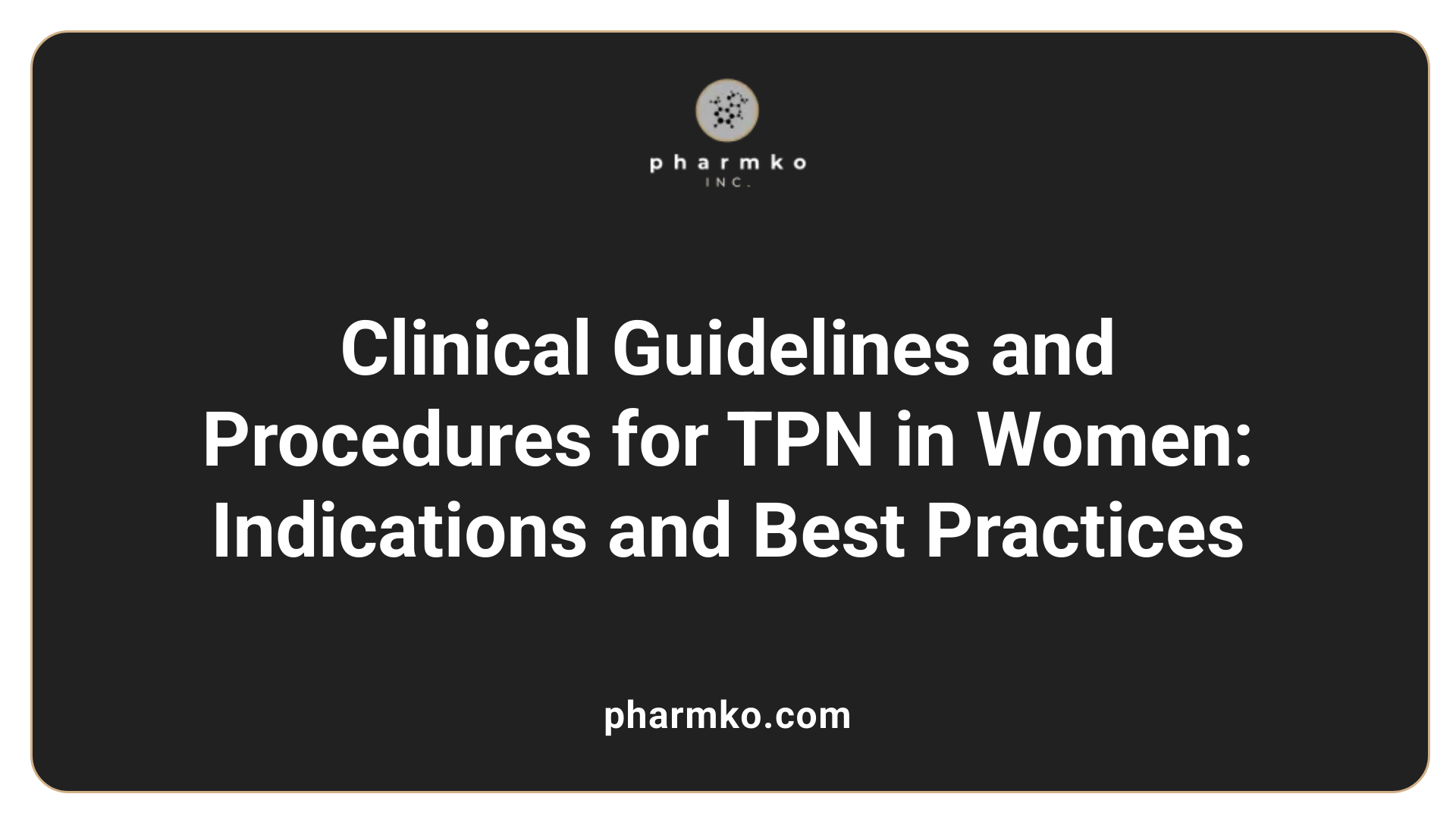
What are the clinical procedures, indications, and considerations for TPN therapy in women?
Total parenteral nutrition (TPN) is a vital intervention for women who are unable to meet their nutritional needs through oral or enteral routes due to various gastrointestinal impairments. This therapy ensures essential nutrients bypass the digestive system, directly entering the bloodstream via a central venous catheter.
Common indications for TPN in women include:
- Bowel obstruction
- Short bowel syndrome
- Severe malabsorption conditions such as Crohn’s disease
- Postoperative complications like bowel leaks
- Severe diarrhea or vomiting preventing adequate oral intake
- GI fistulas and other conditions impairing nutrient absorption
- Severe hypercatabolic states following trauma or surgery
Procedural steps for catheter placement
The process begins with careful planning of vascular access. Placement of a central venous catheter, such as a PICC line, tunneled catheter, or implantable port, involves sterilization, local anesthesia, and sometimes imaging guidance like ultrasound or X-ray to ensure precise positioning.
Once inserted, the catheter requires meticulous line care and verification to prevent complications like bloodstream infections or thrombosis. Nurses and specialized clinicians handle connection procedures, ensuring aseptic technique to maintain sterility.
Customization of nutrient formulations
TPN solutions are uniquely tailored to individual patient needs based on their medical condition, laboratory results, and nutritional requirements. The formulations include:
| Nutrient Component | Typical Range in TPN | Additional Notes |
|---|---|---|
| Carbohydrates | Dextrose 10-25% | Adjusted according to energy demands |
| Lipids | 20-30% emulsions | Source of essential fatty acids |
| Amino acids | 3-5 g/kg/day | Protein needs vary based on patient |
| Vitamins & Trace Elements | As per prescribed guidelines | Ensures micronutrient adequacy |
| Electrolytes & Minerals | Based on lab values | To maintain electrolyte balance |
This customization aids in optimizing nutrition, minimizing complications, and supporting recovery.
Monitoring parameters and early detection of complications
Continuous and periodic assessment is crucial. Key parameters include:
- Fluid input/output balance
- Serum electrolyte levels
- Liver and kidney function tests
- Blood glucose levels
- Signs of infection at the catheter site
- Lipid levels and triglycerides
- Body weight and nutritional status
Early detection of issues such as hyperglycemia, electrolyte imbalance, infections, or liver dysfunction allows timely interventions to prevent severe complications.
Assessment of contraindications and risks
Before initiating TPN, healthcare providers evaluate contraindications like:
- Functional gastrointestinal tract capable of enteral feeding
- Short duration of therapy needed
- Patient’s overall prognosis and quality of life considerations
Risks associated with TPN include bloodstream infections, catheter-related thrombotic events, metabolic disturbances, liver injury, and gallbladder stasis. Careful patient selection, strict aseptic protocols, and regular monitoring mitigate many of these risks.
An interprofessional team, including physicians, trained nurses, pharmacists, and dietitians, collaborates to ensure safe, effective TPN therapy. They also plan for gradual transition to enteral or oral routes as tolerated, aiming to restore gastrointestinal function whenever possible.
In summary, TPN in women involves precise procedural steps, individualized nutrient tailoring, vigilant monitoring, and continuous risk assessment. Its successful application hinges on coordinated multidisciplinary care and thorough understanding of indications and potential complications.
Coordination of TPN Care by Multidisciplinary Teams for Women
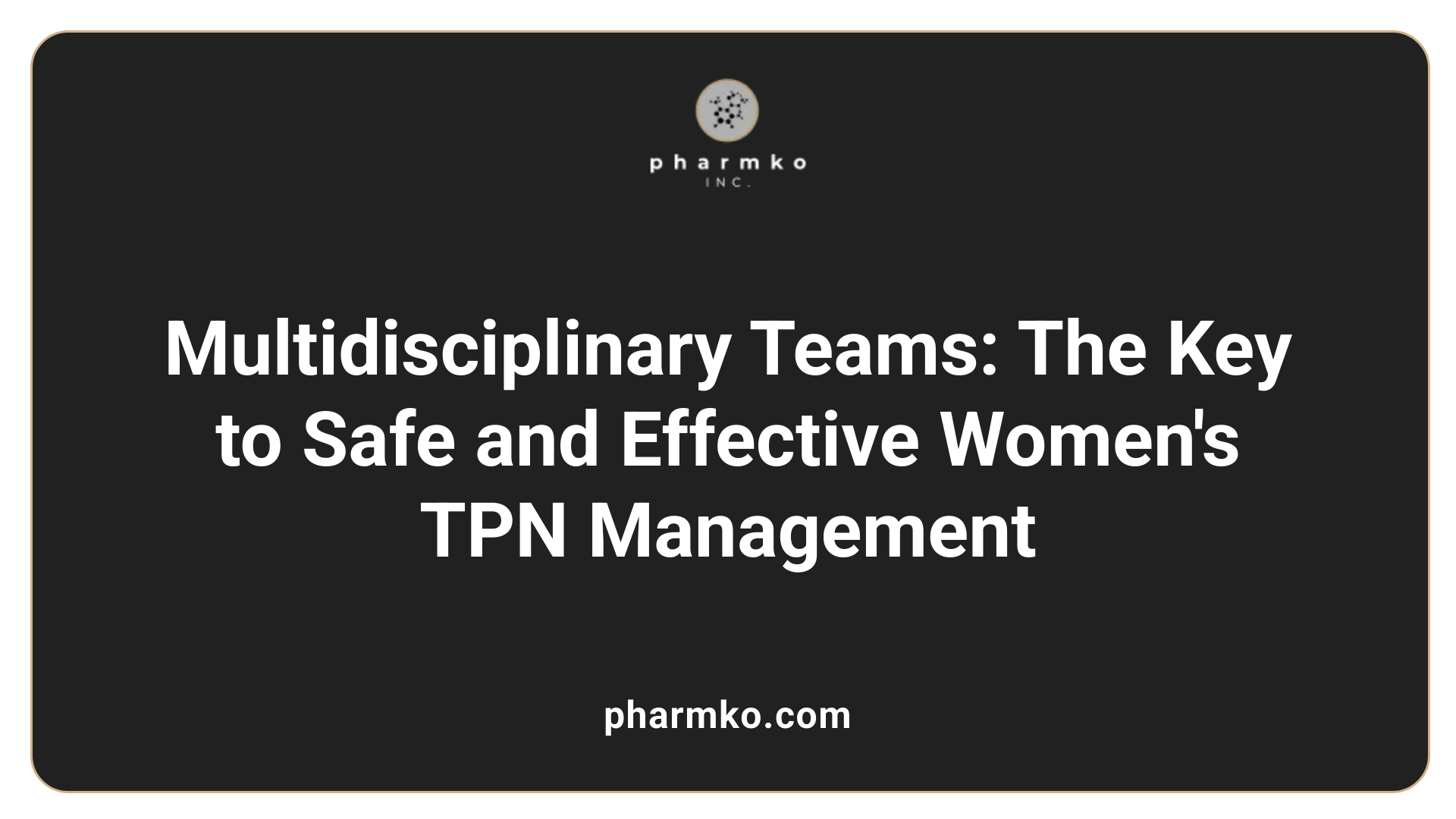
How does a multidisciplinary team coordinate TPN care for women?
The management of total parenteral nutrition (TPN) for women, especially those with complex medical conditions, relies heavily on a collaborative, multidisciplinary team approach. This team typically includes physicians, pharmacists, registered dietitians, nurses, and sometimes mental health professionals, all working together to ensure the safest and most effective nutritional support.
One of the primary tasks of this team is to develop an individual nutritional plan tailored to the woman’s specific needs. This involves assessing her medical condition, gastrointestinal function, nutritional deficits, and overall health status. Based on this comprehensive evaluation, the team formulates a plan that specifies the composition of TPN, including macro- and micronutrients, and delivery methods.
Once a plan is established, the team conducts regular assessments to monitor the woman's response to therapy. These assessments include checking laboratory results (electrolytes, blood glucose, liver and kidney function), clinical signs of complications, and nutritional markers. This ongoing evaluation allows the team to make timely adjustments to the TPN formulation, ensuring optimal nutrient delivery and minimizing risks.
Pharmacists, especially those with specialized training in nutrition support, play a crucial role within this team. They are responsible for independently adjusting TPN formulations based on lab results and clinical changes, managing medication compatibility with nutritional solutions, providing patient education, and overseeing the preparation and verification of the TPN solution. Their expertise ensures safety and cost-efficiency.
Effective communication is critical for successful coordination. Shared electronic health records facilitate real-time data sharing, collaborative decision-making, and documentation, reducing errors and improving transparency. Adherence to clinical guidelines—such as those provided by professional organizations—guides the team in implementing evidence-based practices.
This collaborative model aims to achieve proper nutritional goals, prevent complications such as infections or metabolic disturbances, and ensure the right route of nutrient delivery. Although the evidence varies regarding the overall superiority of team-based care, numerous studies highlight its benefits in reducing mechanical complications, improving nutritional fulfillment, and decreasing healthcare costs.
In summary, a well-coordinated multidisciplinary approach ensures that TPN for women is personalized, monitored diligently, and adjusted promptly. The combined expertise and communication among team members foster safer outcomes, better adherence to treatment goals, and improved quality of life for women requiring TPN.
Maintaining Safety and Managing Risks in Women Receiving TPN

How is safety maintained and risks managed during TPN therapy for women?
Providing total parenteral nutrition (TPN) to women requires meticulous attention to safety protocols to minimize complications and ensure optimal outcomes. Central to this process is the strict adherence to aseptic techniques during all phases of catheter insertion, maintenance, and line handling. Women receiving TPN are particularly vulnerable to bloodstream infections, which can occur if protocols are not rigorously followed. Therefore, healthcare professionals emphasize sterile procedures and proper line care to reduce infection risk.
Monitoring plays a vital role in safe TPN administration. Regular assessment of laboratory parameters such as electrolytes, blood glucose, and liver function helps detect metabolic disturbances early. Hyperglycemia, electrolyte imbalances, or liver complications can develop if these factors are not carefully watched and corrected promptly. Blood glucose levels, in particular, warrant close monitoring because TPN solutions are often rich in dextrose, which can cause elevated blood sugar levels.
Choosing the appropriate venous access is essential to minimize vascular complications. Central venous catheters, including peripherally inserted central catheters (PICC lines), implantable ports, or tunneled catheters, are preferred because they can accommodate the hyperosmolar TPN solutions and reduce the risk of vein damage. The selection depends on the duration of therapy and individual patient circumstances.
Protocol adherence and staff training are fundamental components of safety. Nurses and other healthcare team members must follow established guidelines for line insertion, care, and dressing changes. Continuous staff education and competency assessments ensure that personnel maintain proper aseptic techniques and are up-to-date with the latest safety standards.
Assessment of complications is ongoing throughout TPN therapy. Signs of catheter-related infections, thrombosis, or metabolic abnormalities are closely monitored. Early detection allows for timely interventions, which might include line removal, antimicrobial treatment, or adjustments in the nutritional formulation. Multidisciplinary collaboration among clinicians, pharmacists, dietitians, and nurses ensures a comprehensive approach to patient safety.
In summary, the safety and management of risks during TPN therapy in women hinge on strict aseptic practices, vigilant monitoring, appropriate venous access, thorough staff training, and swift response to complications. This holistic approach not only reduces adverse events but also supports the overall health and well-being of women undergoing TPN treatment.
The Importance of Specialized Training and Evidence-Based Practice in TPN for Women
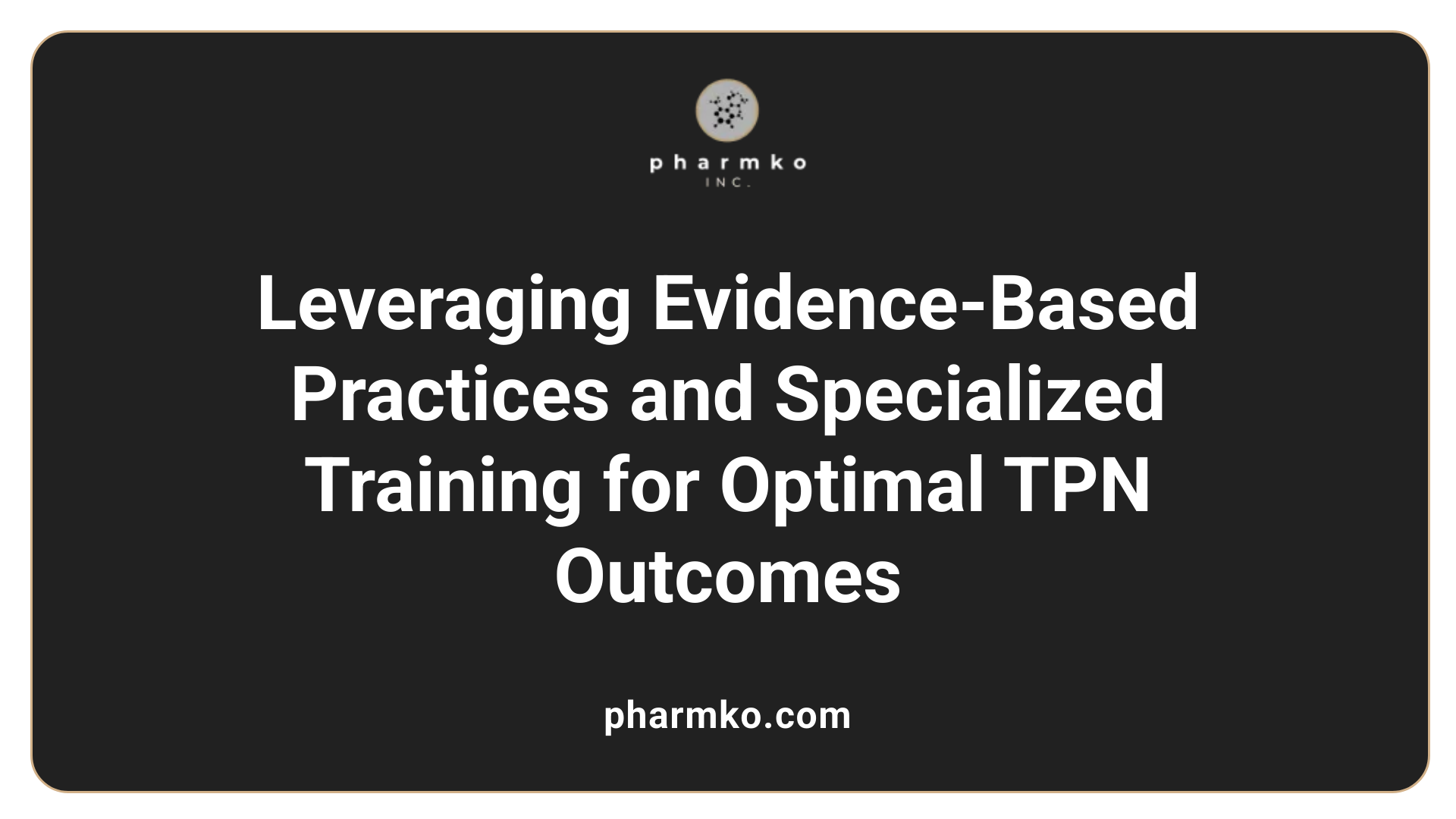
Why is specialized training and evidence-based practice important in TPN management for women?
Managing total parenteral nutrition (TPN) effectively requires a high level of expertise and adherence to the latest clinical guidelines. For women, particularly those with complex medical conditions or unique nutritional needs, specialized training ensures that healthcare professionals understand the intricacies of TPN therapy. This encompasses correct prescribing, precise compounding, and safe administration of nutrient solutions.
Errors in preparation or administration can lead to severe complications, including infections, metabolic imbalances, or even life-threatening conditions. By adhering to evidence-based practices promoted by authoritative organizations like the American Society for Parenteral and Enteral Nutrition (ASPEN), clinicians can maintain high standards of care. These guidelines provide standardized protocols for TPN formulation, monitoring, and complication management, reducing variability and enhancing safety.
An informed and trained team facilitates clear and effective communication across disciplines — including physicians, pharmacists, dietitians, and nurses — which is crucial for timely interventions and continuous patient monitoring. For women receiving TPN, especially during pregnancy, cancer therapy, or with specific gastrointestinal disorders, this collaborative approach ensures personalized, effective treatment.
Utilizing technology such as electronic health records (EHRs) and clinical decision support systems helps prevent prescribing errors and alerts clinicians to potential incompatibilities or metabolic risks. Regular ongoing education keeps healthcare providers updated on emerging research, new formulations, and safety practices.
In summary, structured training combined with robust, evidence-based protocols provides a foundation for safe, reliable TPN management. This approach not only minimizes risks like Refeeding Syndrome, infections, or nutrient imbalances but also promotes optimal recovery and quality of life for women requiring complex nutritional support.
Optimizing TPN Outcomes through Team-Based Care
Effective management of TPN in women hinges on a well-coordinated, multidisciplinary team approach that emphasizes individualized care, rigorous safety protocols, and continuous education. The collaboration among physicians, pharmacists, dietitians, and nurses not only enhances clinical outcomes but also minimizes risks, ensuring that women receiving TPN achieve optimal nutritional health. As clinical practices evolve, adherence to evidence-based guidelines, specialized training, and leveraging technological advances remain essential pillars supporting safe, effective, and patient-centered TPN therapy. By fostering a culture of teamwork, communication, and ongoing professional development, healthcare teams can significantly improve the quality of care and life for women requiring TPN.
References
- Total Parenteral Nutrition - StatPearls - NCBI Bookshelf
- The Nurse's Role in Total Parenteral Nutrition Administration
- Parenteral Nutrition: What it Is, Uses & Types - Cleveland Clinic
- Nutrition Support - NCBI
- A Guide to Home Parenteral Nutrition for New Patients
- [PDF] Navigating Home Care: Parenteral Nutrition—Part Two
- Total Parenteral Nutrition and the Team - JAMA Network
- Total parenteral nutrition for patients with gastrointestinal cancers
- Total Parenteral Nutrition (TPN) And Mental Health
- Parenteral Nutrition Therapy: - ASPEN



